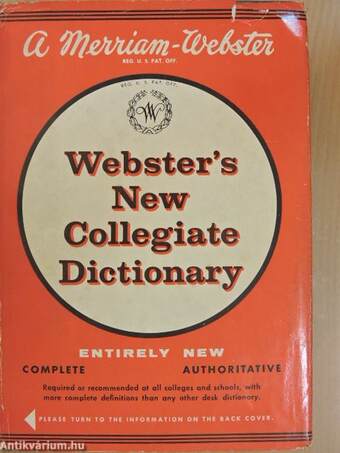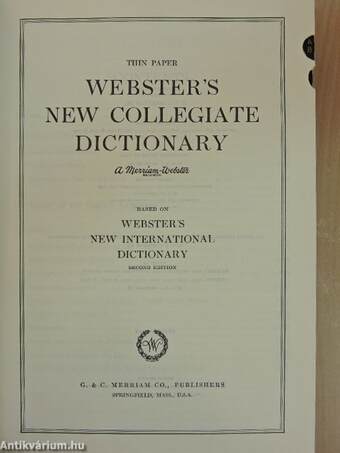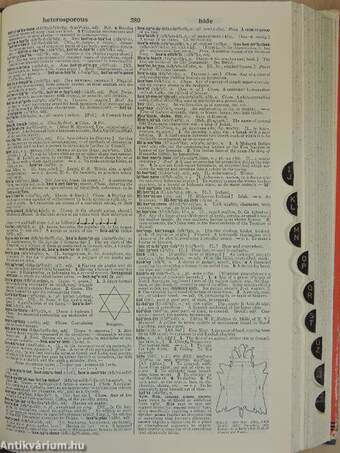1.068.029
kiadvánnyal nyújtjuk Magyarország legnagyobb antikvár könyv-kínálatát

VISSZA
A TETEJÉRE
JAVASLATOKÉszre-
vételek
Webster's New Collegiate Dictionary
| Kiadó: | G. & C. Merriam Co., Publishers |
|---|---|
| Kiadás helye: | Springfield |
| Kiadás éve: | |
| Kötés típusa: | Vászon |
| Oldalszám: | 1.174 oldal |
| Sorozatcím: | |
| Kötetszám: | |
| Nyelv: | Angol |
| Méret: | 25 cm x 17 cm |
| ISBN: | |
| Megjegyzés: | Regiszteres kiadás. Fekete-fehér ábrákkal. |
naponta értesítjük a beérkező friss
kiadványokról
naponta értesítjük a beérkező friss
kiadványokról
Előszó
PREFACE History of the Collegiate. Webster's New Collegiate Dictionary is an entirely new book - newly edited and typeset and presented in a new formát. It will, however, have for many persons the... TovábbElőszó
PREFACE History of the Collegiate. Webster's New Collegiate Dictionary is an entirely new book - newly edited and typeset and presented in a new formát. It will, however, have for many persons the characteristics of an old friend; for it is but the latest member of the century-old Merriam-Webster family. For many years Merriam-Webster dictionaries have förmed a series, in which the unabridged dictionary is the parent work and the Collegiate Dictionary the largest abridgment. From each successive revision of the unabridged work new abridged books have sprung. In 1898 the first edition of the Collegiate appeared. Its size, appearance, typography, and, above all, its wealth of material and scholarly presentation quickly won for it a high place in the regard of both generál reader and scholar. In 1910 a second edition appeared, followed by new editions or revisions in 1916 (the third), 1931 (the fourth), and 1936 (the fifth). This New Collegiate (the sixth) incorporates the best of the time-tested features of its predecessors. Scope and Formát. The generál eontent and over-all plan of the previous edition (Webster's Collegiate Dictionary, Fifth Edition) have proved so weil adapted to the needs of its users that any attempt to change its essential eharacter and form seemed inadvisable. The editors felt, too, that there were relatively few entries, both in its main vocabulary and in the special sections, that could be omitted without loss to the user of Webster's New Collegiate. At the same time, there were many new terms and meanings, many older terms and meanings of increasing importance or frequency, many abbreviations, and many proper names that must be added in a new edition. The problem was how to retain most of the material of the previous work while adding material essential to the new book without markedly increasing its physical size. The new formát of the present book is the answer. The wider page, with its wider column, has enabled the editors to achieve this dual aim within a handy-sized volume. Typography. The type faces used in this book are those of the New International, Second Edition, for which they were carefully chosen, after extensive experimenting, for their appearance and readability. These type faces have stood the further tests of time and use in the previous edition of the Collegiate. The General Vocabulary. Once again the vocabulary of the Collegiate has been selected to meet the needs both of the college student and of the generál reader seeking clear and accurate, but not encyclopedic, information. Every entry and every definition of the previous edition has been reviewed, and many of them have been revised to incorporate additional, often new, information or to effect improvements in the former presentation. The definitions have for the most part been based on the most recent available information contained in the latest printings of the parent work, Webster's New International Dictionary, Second Edition, with such modifications or adaptations as are required by the smaller scope of the Collegiate. Wherever they are needed and, indeed, as freely as possible within the limitations of the space, phrases and sentences have been given that illustrate the definitions. The literary vocabulary contains many additions, consisting principally of new terms and meanings and somé older ones of increased importance or frequency, the inclusion of which is often the direct result of suggestions from users of the previous edition. The New Collegiate follows the practice of its predecessors in including only a limited selection of slang, dialectal, and obsolete terms and meanings. Since behind the present work are all the vast resources of the New International, Second Edition, containing somé 550,000 vocabulary entries, the problem has been one of selection of terms to be included here. Usefulness has been the criterion. Special Subjects. The greater emphasis on the vocabularies of technical and scientific fields, which was perhaps the most noticeable difference between the previous edition and earlier Collegiates, has been continued in this New Collegiate. The wealth of information prepared by the 207 Consulting editors for the New International, Second Edition, has been freely drawn (iv) VisszaTartalom
CONTENTSPage
Preface iv
Introductory Matter
Guide to Pronunciation vii
Explanatory Notes xviii
Abbreviations Used in this Work xxi
Dictionary of the English Language 1
Appendixes
Abbreviations Used in Writing and Printing 998
Arbitrary Signs and Symbols 1008
Biographical Names 10^0
Pronouncing Gazetteer 1054
Pronouncing Vocabulary of Common English Given Names 1131
Vocabulary of Rhymes 1138
Orthography 1145
Punctuation, Compounds, Capitals, etc 1148
Preparation of Copy for the Press l to7
Colleges and Universities in the United States and Canada 1160














